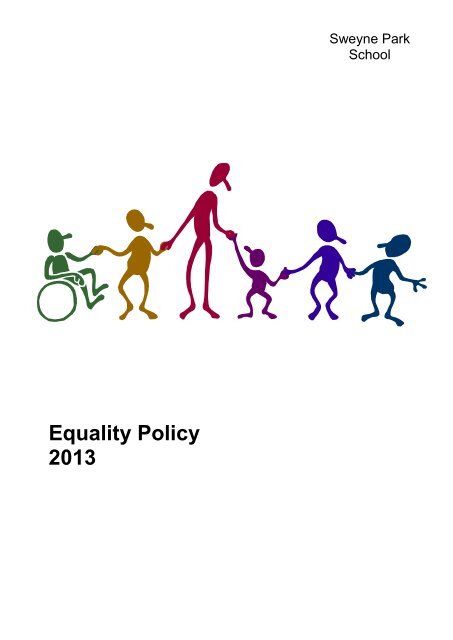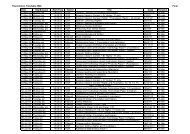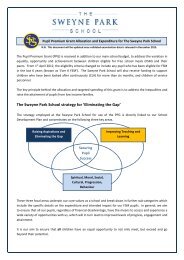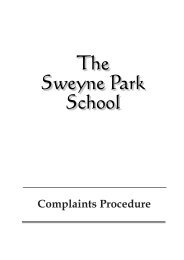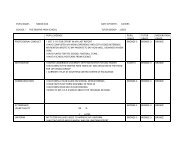Equality Policy - The Sweyne Park School
Equality Policy - The Sweyne Park School
Equality Policy - The Sweyne Park School
You also want an ePaper? Increase the reach of your titles
YUMPU automatically turns print PDFs into web optimized ePapers that Google loves.
<strong>Equality</strong> <strong>Policy</strong><br />
2013<br />
<strong>Sweyne</strong> <strong>Park</strong><br />
<strong>School</strong>
<strong>Equality</strong> <strong>Policy</strong><br />
1. Vision<br />
2. Mainstreaming equality into policy and practice<br />
3. Equal Opportunities for Staff<br />
4. <strong>Equality</strong> and the law<br />
a. Race<br />
b. Disability<br />
c. Gender<br />
d. Sexual orientation<br />
e. Community cohesion<br />
5. Consultation<br />
6. Roles and Responsibilities<br />
7. Tackling discrimination<br />
8. Review of progress and impact<br />
9. Publishing the plan<br />
10. Action Plan<br />
1. Vision<br />
At <strong>Sweyne</strong> <strong>Park</strong> <strong>School</strong>, we are committed to securing pupil success. This involves<br />
ensuring equality of education and opportunity for all pupils, staff, parents and carers<br />
receiving services from the school, irrespective of race, gender, disability, faith or socioeconomic<br />
background. We aim to develop a culture of respect, inclusion and diversity in<br />
which all those connected to the school feel proud of their identity and able to participate<br />
fully in school life.<br />
<strong>The</strong> achievement of pupils will be monitored by race, gender and disability and we will use<br />
this data to support pupils, raise standards and ensure inclusive teaching. We will tackle<br />
discrimination by the positive promotion of equality, challenging bullying and stereotypes<br />
and creating an environment which champions respect for all. We believe that diversity is a<br />
strength which should be respected and celebrated by all those who learn, teach and visit<br />
here.<br />
2. Mainstreaming equality into policy and practice<br />
As well as the specific actions set out in this plan, the school operates equality of<br />
opportunity in its day to day practice in the following ways:<br />
Teaching and learning<br />
We aim to provide all our pupils with the opportunity to succeed, and to reach the highest<br />
level of personal achievement. To do this, we will:<br />
Use contextual data to improve the ways in which we provide support to individuals<br />
and groups of pupils;<br />
Monitor achievement data by ethnicity, gender and disability and action any gaps;<br />
Take account of the achievement of all pupils when planning for future learning and<br />
setting challenging targets;<br />
Ensure equality of access for all pupils and prepare them for life in a diverse society;<br />
Use materials that reflect the diversity of the school, population and local community<br />
in terms of race, gender and disability, without stereotyping;<br />
Promote attitudes and values that will challenge racist and other discriminatory<br />
behaviour or prejudice;<br />
Provide opportunities for pupils to appreciate their own culture and celebrate the<br />
diversity of other cultures;<br />
Page 2 of 14
Seek to involve all parents in supporting their child’s education;<br />
Include teaching and classroom-based approaches appropriate for the whole school<br />
population, which are inclusive and reflective of our ethos of respect.<br />
Admissions and exclusions<br />
Our admissions arrangements are fair and transparent, and do not discriminate on race,<br />
gender, disability or socio-economic factors.<br />
Exclusions will always be based on the school’s Behaviour <strong>Policy</strong>. We will closely monitor<br />
exclusions to avoid any potential adverse impact and ensure any discrepancies are<br />
identified and examined.<br />
3. Equal Opportunities for Staff<br />
This section deals with aspects of equal opportunities relating to staff at <strong>Sweyne</strong> <strong>Park</strong><br />
<strong>School</strong>.<br />
We are committed to the implementation of equal opportunities principles and the<br />
monitoring and active promotion of equality in all aspects of staffing and employment.<br />
All staff appointments and promotions are made on the basis of merit and ability and in<br />
compliance with the law. However, we are concerned to ensure wherever possible, that the<br />
staffing of the school reflects the diversity of our community.<br />
Employer duties<br />
As an employer we need to ensure that we continue to eliminate discrimination and<br />
harassment in our employment practice and actively promote equality across all groups<br />
within our workforce.<br />
<strong>Equality</strong> aspects such as gender, race, disability, sexual orientation, gender re-assignment<br />
and faith or religion are considered when appointing staff and particularly when allocating<br />
Teaching and Learning Responsibilities (TLR) or re-evaluating staff structures, to ensure<br />
decisions are free from discrimination.<br />
Actions to ensure this commitment is met include:<br />
Monitoring recruitment and retention including bullying and harassment of staff;<br />
Continued professional development opportunities for all staff;<br />
Senior Leadership Team support to ensure equality of opportunity for all.<br />
4. <strong>Equality</strong> and the law<br />
<strong>The</strong>re are a number of statutory duties that must be met by every school in line with<br />
legislation from the Race Relations (Amendment) Act (2000), Disability <strong>Equality</strong> Duty (2005)<br />
and <strong>Equality</strong> Act (2006).<br />
<strong>The</strong> action plan at the end of this <strong>Equality</strong> Plan outlines the actions we will take to meet the<br />
general duties detailed below.<br />
Page 3 of 14
4a. Race <strong>Equality</strong><br />
This section of the plan reflects the general and specific duties of schools as detailed in <strong>The</strong><br />
Race Relations Act 1976 and as amended by <strong>The</strong> Race Relations (Amendment) Act 2000.<br />
<strong>The</strong> General Race <strong>Equality</strong> Duty requires us to have due regard to the need to:<br />
Eliminate racial discrimination;<br />
Promote equality of opportunity;<br />
Promote good relations between people of different racial groups.<br />
Under our specific duty we will:<br />
Assess the impact of our policies, including this Plan, on pupils, staff and parents by<br />
ethnicity including, in particular, the achievement levels of these pupils;<br />
Monitor the impact our plans and policies have on such pupils, staff and parents<br />
towards raising the achievement of minority ethnic groups.<br />
4b. Disability<br />
This section should be read in conjunction with the school’s Special Educational Needs<br />
Inclusion <strong>Policy</strong> and Disability <strong>Equality</strong> Scheme.<br />
Definition of disability<br />
<strong>The</strong> Disability Discrimination Act 2005 (DDA) defines a disabled person as someone who<br />
has ‘a physical or mental impairment which has a substantial or long-term adverse effect on<br />
his or her ability to carry out normal day-to-day activities’.<br />
<strong>The</strong> DDA (2005) has also extended the definition of disability as follows:<br />
○ People with HIV, multiple sclerosis and cancer (although not all cancers) are<br />
deemed disabled before they experience the long-term and substantial adverse<br />
effect on their activities;<br />
○ Section 18 has been amended so that individuals with a mental illness no longer<br />
have to demonstrate that it is “clinically well-recognised”, although the person<br />
must still demonstrate a long-term and substantial adverse impact on his/her<br />
ability to carry out normal day-to-day activities.<br />
Legal duties<br />
<strong>The</strong> Disability Discrimination Act (DDA 2005) placed a general duty on schools, requiring<br />
them to have due regard for the following when carrying out and delivering services:<br />
Promoting equality of opportunity between disabled people and other people;<br />
Eliminating discrimination and harassment of disabled people that is related to their<br />
disability;<br />
Promoting positive attitudes towards disabled people;<br />
Encouraging participation in public life by disabled people;<br />
Taking steps to meet disabled people’s needs, even if this requires more favourable<br />
treatment.<br />
Under our specific duty we will:<br />
Publish a Disability <strong>Equality</strong> Scheme which covers these requirements and review<br />
this scheme every three years. (Appendix A)<br />
Page 4 of 14
4c. Gender <strong>Equality</strong><br />
<strong>The</strong> Gender <strong>Equality</strong> Duty 2006 places a general and specific duty on schools to eliminate<br />
unlawful discrimination and harassment on the grounds of gender and to promote equality<br />
of opportunity between female and male pupils and between women and men and<br />
transgender people.<br />
Under our general duty we will actively seek to:<br />
Eliminate unlawful discrimination and harassment on grounds of sex and gender<br />
reassignment;<br />
Promote equality between men and women.<br />
Under our specific duty we will:<br />
Prepare and publish an <strong>Equality</strong> Opportunities <strong>Policy</strong> which covers the requirements<br />
and review and revise this policy every three years.<br />
4d. Sexual Orientation<br />
<strong>The</strong> <strong>Equality</strong> Act 2006 made provision for regulations to be introduced to extend protection<br />
against discrimination on grounds of religion or belief to sexual orientation.<br />
<strong>The</strong> <strong>Equality</strong> Act (Sexual Orientation) Regulations 2007 came into force on 30 April 2007,<br />
and they make discrimination unlawful in the area of goods, facilities and services on<br />
grounds of sexual orientation. For schools this means admissions, benefits and services for<br />
pupils and treatment of pupils.<br />
4e. Community cohesion<br />
<strong>The</strong> Education and Inspections Act 2006 inserted a new section 21(5) to the Education Act<br />
2002, introducing a duty on the governing bodies of state schools to promote community<br />
cohesion. Community cohesion encompasses promoting good relations between pupils<br />
from different races, faiths / beliefs and socio-economic backgrounds. <strong>The</strong> duty came into<br />
force on 1 September 2007. <strong>The</strong> school currently has a Community Cohesion <strong>Policy</strong>.<br />
5. Consultation and involvement<br />
It is a requirement that the development of this plan and the actions within it have been<br />
informed by the input of staff, pupils and parents and carers. We have achieved this by<br />
using the following to shape the plan:<br />
Feedback from the annual parent questionnaire, parents’ evenings, PTA and<br />
Parent forum meetings<br />
Feedback from the school council, CPRE lessons, whole school surveys on<br />
children’s attitudes to self and school.<br />
Issues raised in annual reviews or reviews of progress on Individual Education<br />
Plans, mentoring and support;<br />
Feedback at Governing body meetings.<br />
6. Roles and Responsibilities<br />
<strong>The</strong> role of governors<br />
<br />
<br />
<strong>The</strong> governing body has set out its commitment to equal opportunities in this plan<br />
and it will continue to do all it can to ensure that the school is fully inclusive to<br />
pupils, and responsive to their needs based on race, gender and disability.<br />
<strong>The</strong> governing body seeks to ensure that people are not discriminated against<br />
when applying for jobs at our school on grounds of race, gender or disability.<br />
Page 5 of 14
<strong>The</strong> governors take all reasonable steps to ensure that the school environment<br />
gives access to people with disabilities, and also strive to make school<br />
communications as inclusive as possible for parents, carers and pupils.<br />
<strong>The</strong> governors welcome all applications to join the school, whatever a child’s socioeconomic<br />
background, race, gender or disability.<br />
<strong>The</strong> governing body ensures that no child is discriminated against whilst in our<br />
school on account of their race, sex or disability.<br />
<strong>The</strong> role of the headteacher (or senior leader responsible for Equalities)<br />
<br />
<br />
<br />
<br />
<br />
It is the headteacher’s role to implement the school’s <strong>Equality</strong> Plan and he is<br />
supported by the governing body in doing so.<br />
It is the headteacher’s role to ensure that all staff are aware of the <strong>Equality</strong> Plan,<br />
and that teachers apply these guidelines fairly in all situations.<br />
<strong>The</strong> headteacher ensures that all appointments panels give due regard to this plan,<br />
so that no-one is discriminated against when it comes to employment or training<br />
opportunities.<br />
<strong>The</strong> headteacher promotes the principle of equal opportunity when developing the<br />
curriculum, and promotes respect for other people and equal opportunities to<br />
participate in all aspects of school life.<br />
<strong>The</strong> headteacher treats all incidents of unfair treatment and any incidents of<br />
bullying or discrimination, including racist incidents, with due seriousness.<br />
<strong>The</strong> role of all staff: teaching and non-teaching<br />
<br />
<br />
<br />
<br />
All staff will ensure that all pupils are treated fairly, equally and with respect, and<br />
will maintain awareness of the school’s <strong>Equality</strong> Plan.<br />
All staff will strive to provide material that gives positive images based on race,<br />
gender and disability, and challenges stereotypical images.<br />
All staff will challenge any incidents of prejudice, racism or homophobia, and record<br />
any serious incidents, drawing them to the attention of the headteacher.<br />
Teachers support the work of ancillary or support staff and encourage them to<br />
intervene in a positive way against any discriminatory incidents.<br />
7. Tackling discrimination<br />
Harassment on account of race, gender, disability or sexual orientation is unacceptable and is<br />
not tolerated within the school environment.<br />
All staff are expected to deal with any discriminatory incidents that may occur. <strong>The</strong>y are<br />
expected to know how to identify and challenge prejudice and stereotyping; and to support<br />
the full range of diverse needs according to a pupil’s individual circumstances.<br />
Racist and homophobic incidents and other incidents of harassment or bullying are dealt with<br />
by the member of staff present, escalating to a class teacher/Head of Year/member of the<br />
Leadership Team/headteacher where necessary. All incidents are reported to the headteacher<br />
via the school’s anti-bullying log, and racist incidents are reported to the governing body and<br />
local authority on a termly basis.<br />
What is a discriminatory incident<br />
Harassment on grounds of race, gender, disability, sexual orientation or other factors such as<br />
socio-economic status, can take many forms including verbal or physical abuse, name calling,<br />
exclusion from groups and games, unwanted looks or comments, jokes and graffiti.<br />
A racist incident is defined by the Stephen Lawrence Inquiry Report (1999) as:<br />
‘any incident which is perceived to be racist by the victim or any other person’.<br />
Page 6 of 14
Types of discriminatory incident<br />
Types of discriminatory incidents that can occur are:<br />
<br />
<br />
<br />
<br />
<br />
<br />
<br />
<br />
<br />
<br />
<br />
Physical assault against a person or group because of their colour, ethnicity,<br />
nationality, disability, sexual orientation or gender;<br />
Use of derogatory names, insults and jokes;<br />
Racist, sexist, homophobic or discriminatory graffiti;<br />
Provocative behaviour such as wearing racist, sexist, homophobic or<br />
discriminatory badges or insignia;<br />
Bringing discriminatory material into school;<br />
Verbal abuse and threats;<br />
Incitement of others to discriminate or bully due to victim’s race, disability,<br />
gender or sexual orientation;<br />
Discriminatory comments in the course of discussion;<br />
Attempts to recruit others to discriminatory organisations and groups;<br />
Ridicule of an individual for difference e.g. food, music, religion, dress etc;<br />
Refusal to co-operate with other people on grounds of race, gender, disability or<br />
sexual orientation.<br />
Responding to and reporting incidents<br />
It should be clear to pupils and staff how they report incidents. All staff, teaching and nonteaching,<br />
should view dealing with incidents as vital to the well-being of the whole school.<br />
8. Review of progress and impact<br />
<strong>The</strong> Plan has been agreed by our Governing Body. We have a rolling programme for<br />
reviewing our school policies and their impact. In line with legislative requirements, we will<br />
review progress against our <strong>Equality</strong> Plan annually and review the entire plan and<br />
accompanying action plan on a three year cycle.<br />
We make regular assessments of pupils’ learning and use this information to track pupil<br />
progress. As part of this process, we regularly monitor achievement by ethnicity, gender<br />
and disability, to ensure that all groups of pupils are making the best possible progress, and<br />
take appropriate action to address any gaps.<br />
9. Publishing the plan<br />
In order to meet the statutory requirements to publish a Disability <strong>Equality</strong> Scheme and<br />
Gender <strong>Equality</strong> Scheme, we will:<br />
Publish our plan on the school website;<br />
Raise awareness of the plan through the school newsletter, assemblies, staff<br />
meetings and other communications;<br />
Make sure hard copies are available.<br />
Signed:<br />
Date:<br />
Page 7 of 14
10. ACTION PLAN<br />
<strong>Equality</strong><br />
Strand<br />
All<br />
Action<br />
Publish and promote the <strong>Equality</strong> <strong>Policy</strong><br />
through the school website, newsletter and<br />
staff meetings.<br />
How will the impact of the<br />
action be monitored<br />
Question about parent<br />
awareness of <strong>Equality</strong><br />
<strong>Policy</strong> in annual survey.<br />
Who is<br />
responsible for<br />
implementing<br />
Headteacher /<br />
designated<br />
member of<br />
staff<br />
What are the<br />
time frames<br />
Immediately<br />
after <strong>Equality</strong><br />
<strong>Policy</strong> is<br />
reviewed and<br />
agreed by<br />
governing<br />
body<br />
Early success<br />
indicators<br />
Staff are familiar with<br />
the principles of the<br />
<strong>Equality</strong> <strong>Policy</strong> and<br />
use them when<br />
planning lessons,<br />
creating class room<br />
displays.<br />
Parents are aware of<br />
the <strong>Equality</strong> <strong>Policy</strong><br />
All<br />
Monitor and analyse pupil achievement by<br />
race, gender and disability and act on any<br />
trends or patterns in the data that require<br />
additional support for pupils. This will<br />
include our FSM pupils.<br />
Achievement data is<br />
analysed by race, gender,<br />
FSM entitlement and<br />
disability<br />
Headteacher /<br />
Governing<br />
body<br />
Annually<br />
when SEF is<br />
done<br />
Analysis of teacher<br />
assessments / annual<br />
data demonstrates<br />
the gap is narrowing<br />
for equality groups.<br />
As a result of progress made : Assistant<br />
Headteacher with a specific responsibility for<br />
this area appointed.<br />
April 2013<br />
Gap in progress made<br />
reduced to 10%<br />
variance.<br />
All<br />
Ensure all pupils are given the opportunity to<br />
make a positive contribution to the life of the<br />
school e.g. through involvement in the<br />
<strong>School</strong> Council by election or co-option),<br />
class assemblies, Rights Respecting <strong>School</strong>.<br />
<strong>School</strong> and year council<br />
representation monitored<br />
by race, gender, disability<br />
Members of<br />
staff leading on<br />
school council<br />
and Rights<br />
Respecting<br />
<strong>School</strong><br />
From<br />
September<br />
2011<br />
More diversity in<br />
school and year<br />
council membership.<br />
Rights Respecting<br />
<strong>School</strong> Award<br />
achieved and<br />
embedded<br />
Race<br />
<strong>Equality</strong><br />
Duty<br />
Continue to identify, respond and report<br />
racist incidents as outlined in the <strong>Policy</strong>.<br />
Report the figures to the Governing body on<br />
a termly and the Local Authority on an<br />
annual basis.<br />
<strong>The</strong> Headteacher /<br />
Governing body will use<br />
the data to assess the<br />
impact of the school’s<br />
response to incidents.<br />
Headteacher /<br />
Governing<br />
body<br />
Reporting:<br />
December,<br />
April, July<br />
Teaching staff<br />
continue to be aware<br />
of and respond to<br />
racist incidents
10. ACTION PLAN<br />
<strong>Equality</strong><br />
Strand<br />
Community<br />
cohesion<br />
All<br />
Action<br />
Celebrate cultural events throughout the<br />
year to increase pupil awareness and<br />
understanding of different communities e.g.<br />
One World Week.<br />
Accelerate the progress of disabled pupils in<br />
terms of 5A*-C in English and Maths GCSE.<br />
How will the impact of the<br />
action be monitored<br />
RE assessments and<br />
through Pupil Voice<br />
activities.<br />
Data and progress analysis<br />
at Leadership Team<br />
meetings<br />
Who is<br />
responsible for<br />
implementing<br />
Member of<br />
staff leading on<br />
RE<br />
Leadership<br />
Team<br />
What are the<br />
time frames<br />
Ongoing<br />
Early success<br />
indicators<br />
Increased awareness<br />
evident in RE<br />
assessments and<br />
pupils voice<br />
discussions.<br />
International <strong>School</strong>s<br />
Award achieved.
<strong>The</strong> <strong>Sweyne</strong> <strong>Park</strong> <strong>School</strong> Disability<br />
<strong>Equality</strong> Scheme.<br />
This document forms Appendix A of the <strong>Equality</strong> <strong>Policy</strong>.<br />
3-year period covered by the plan : December 2012-2015.<br />
Introduction<br />
<strong>The</strong> SEN and Disability Act 2001 extended the Disability Discrimination Act 1995 (DDA) to cover education.<br />
Since September 2002, the Governing Body has had three key duties towards disabled pupils, under Part 4 of the<br />
DDA:<br />
<br />
<br />
<br />
not to treat disabled pupils less favourably for a reason related to their disability;<br />
to make reasonable adjustments for disabled pupils, so that they are not at a substantial<br />
disadvantage;<br />
to plan to increase access to education for disabled pupils.<br />
This plan sets out the proposals of the Governing Body of the school to increase access to education for<br />
disabled pupils in the three areas required by the planning duties in the DDA:<br />
increasing the extent to which disabled pupils can participate in the school curriculum and extra –<br />
curricular activities, while taking due consideration of health and safety issues.<br />
improving the environment of the school to increase the extent to which disabled pupils can take<br />
advantage of education and associated services;<br />
improving the delivery to disabled pupils of information which is provided in writing for pupils<br />
who are not disabled.<br />
It is a requirement that the school’s accessibility plan is resourced, implemented and reviewed and revised as<br />
necessary. Attached is a set of action plans showing how the school will address the priorities identified in the<br />
plan.
1. Starting points<br />
1A: <strong>The</strong> purpose and direction of the school’s plan: vision and<br />
values<br />
<strong>The</strong> <strong>Sweyne</strong> <strong>Park</strong> <strong>School</strong>’s ethos of respect and inclusion promotes meeting<br />
individual needs as it’s core vision.<br />
<strong>The</strong> policies for Equal Opportunities, SEN and Inclusion outline how this<br />
ethos is maintained. This Scheme links with these policies.<br />
1B: Information from pupil data and school audit<br />
<strong>Sweyne</strong> <strong>Park</strong> <strong>School</strong> has 1251 pupils and 168 staff.<br />
<strong>The</strong> number of staff who are known to have a disability as defined in the<br />
Disability Discrimination Act at this time is 8 and the number of pupils is<br />
244.<br />
.<br />
All staff were made aware of the requirements of the DDA when it was<br />
introduced in 2001 and updated information was provided when the Act was<br />
revised in 2005. Information about individual pupil needs and strategies for<br />
meeting these needs is published in Individual Education Plans and on the<br />
school computer system as soon as it becomes available.<br />
As a school with some limitiations for wheelchair access, we have a pupil<br />
who is wheelchair bound and several pupils who have physical and/or<br />
medical disabilities which require considerable support and adaptation.<br />
1C: Views of those consulted during the development of the<br />
plan<br />
<strong>The</strong> parents of one disabled pupil had written to the Headteacher and<br />
Governing Body to support the school persuading the Local Authority to<br />
install a lift to the upper floors. This pupil used crutches to aid mobility and<br />
could get very tired moving around the school all day. This was exacerbated<br />
by the need to negotiate stairs.<br />
Two members of staff have indicated their need for special arrangements to<br />
enable them to carry out their responsibilities. <strong>The</strong>se adaptations to<br />
timetable and working practices and furniture have been implemented.<br />
<strong>The</strong> pupils in the Resource Base for Hearing Impaired Pupils are very<br />
positive about the adaptations made to enable them to access the<br />
curriculum. <strong>The</strong>re is still, however, a problem with transport for extracurricular<br />
activities which the school continues to try to resolve.<br />
<strong>The</strong> school piloted a scheme to treat classrooms to become acoustically<br />
enhanced. This scheme is now ongoing and the next phase has been<br />
implemented.<br />
2. <strong>The</strong> main priorities in the school’s plan
2A: Increasing the extent to which disabled pupils can participate in the school<br />
curriculum<br />
All pupils are taught in mainstream classrooms and have full access to the<br />
National Curriculum and, in Key Stage 4, to accredited courses, and extra<br />
–curricular activities. <strong>The</strong> Resource Base staff, including communicators,<br />
enable our hearing impaired pupils to fully participate in all aspects of school<br />
life.<br />
However the need to solve the problem of flexibility of contracted<br />
transport for disabled pupils continues. <strong>The</strong> current Essex LA policy does<br />
not allow for transport to be available on a flexible timing programme and a<br />
review of this policy has resulted in the decision to maintain this position. As<br />
a result the school needs to continue to fund transport when necessary<br />
.<br />
<strong>The</strong> school’s SEN policy plays a key part in ensuring access to the<br />
curriculum for pupils with special learning needs and those with medical<br />
needs.<br />
Through the use of strategies such as individual support, withdrawal<br />
sessions, staff training and in-class support, we seek to secure pupil<br />
success through a curriculum accessible to all.<br />
<strong>The</strong>re is also a need to ensure that the curriculum continues to include<br />
opportunities to promote disability equality.<br />
2B: Improving the physical environment of the school to increase the extent<br />
to which disabled pupils can take advantage of education and associated<br />
services:<br />
<strong>The</strong> physical environment of the school is the most challenging area for<br />
disabled people. <strong>The</strong> school has access to the ground floor of the<br />
main building at <strong>Sweyne</strong> <strong>Park</strong> near the Pupil Services entrance, through the<br />
use of ramps and hand rails, but limited or no wheelchair access to the upper<br />
floors in certain areas of the school.<br />
Toilets adapted for disabled people are available on the ground floor of the<br />
main buiding and in the Media/Drama block.<br />
<strong>The</strong> installation of a lift has been completed and is now operational in one<br />
part of the main building. This enables access to the upper floors of one<br />
block of the school for pupils and staff who have need for it.<br />
Some widening of doorways, sliding doors at the main pupil entrance, further<br />
ramps and a room suitable for physiotherapy with a hoist and disabled toilet<br />
facilities were completed by September 2011. <strong>The</strong>se developments have
greatly enhanced the inclusion of a year 9 boy who is wheelchair bound.<br />
Adaptations to enable this pupil to begin Art GCSE a year early (painting by<br />
mouth) have also been made. Our D+T technician made a stand for the paint<br />
and we are about to buy a mini i-pad and specific Art software to enbale him<br />
to cover the design element of the course.<br />
Creative use of support staff as escorts has also enabled easier access for<br />
pupils. Where neceassary, lessons for these pupils are timetabled in ground<br />
floor venues.<br />
<strong>The</strong> acoustic environment is good. We have a loop system in<br />
the hall and soundproofed doors in the Resource Base and on several<br />
classrooms. We have also improved the acoustics in several classrooms,<br />
following the successful pilot scheme with the local Authority begun at Easter<br />
2008. This involved a number of classrooms being acoustically treated with<br />
false ceilings, special wallboards and window coverings, to test the effects on<br />
the acoustic environment. <strong>The</strong> latest development in this programme has<br />
been to treat the main hall and Drama studio.<br />
Our alarm system has been adapted to include visual alarms.<br />
Development of signage, particularly directional, has been made.<br />
Windows have reflective film and/or blinds to maximise visual context. A new<br />
phase of replacement windows and wall cladding has been completed.<br />
2C: Improving the delivery to disabled pupils of information that is provided<br />
in writing for pupils who are not disabled:<br />
Our Resource Base staff use BSL and Signed English to enable pupils to<br />
engage with learning and information. DVD’s are subtitled for use in lessons<br />
and communicators are always available for hearing impaired parents.<br />
We have developed the use of DVD’s to explain Health and Safety Issues<br />
and access arrangements.<br />
Many visual teaching resources are employed to enable easier access to the<br />
curriculum for pupils. This includes an interactive whiteboard in every<br />
teaching area.<br />
We have not yet needed to provide information in Braille, but are aware of<br />
how to access this help if it should become necessary.<br />
3: Making it happen<br />
3A: Management, coordination and implementation<br />
As above, plans are in place to enhance the accessibility and learning environment for all our<br />
pupils, staff and building users and especially those with disabilities.
Representatives from the school liaise closely with representatives from the Local Authority and<br />
specialist teachers to develop provision for disabled staff and pupils.<br />
<strong>The</strong> implementation of adaptations to the site are ongoing as funding becomes available and building<br />
work feasible.<br />
Reviews of schemes of work to include positive reference to disability are ongoing and we are<br />
continuously reviewing our provision.<br />
3B: Getting hold of the school’s plan<br />
Please telephone the school on 01268 784721 for a copy of this plan.


